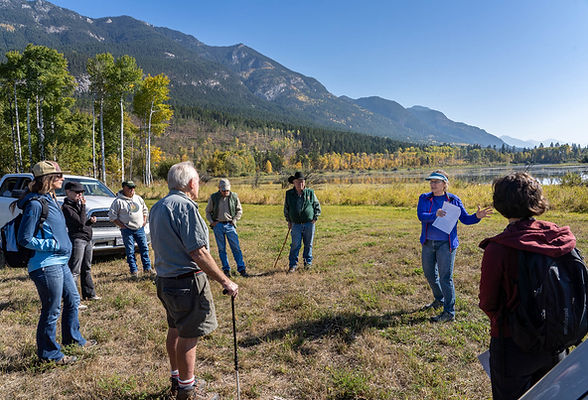
_edited%20(1).png)

The Columbia Headwaters Aquatic Restoration Secwépemc Strategy (CHARS) is an Indigenous led initiative of the Shuswap Band and the Secwépemc Nation that advances reconciliation and capacity building while also providing an opportunity to foster a collaborative, community-based approach to protect and restore Species At Risk. The CHARS contributes to biodiversity goals and supports healthy ecosystems within the tributaries, wetlands, lakes, and mainstem Columbia River from Donald, BC, upstream to its headwaters at Columbia Lake and Dutch Creek within the Rocky Mountains in Southeastern British Columbia. On-the-ground restoration as done through the CHARS plays a pivotal role in enhancing ecosystems, conserving nature, and honoring First Nations values as it is a low-risk, high-value approach that empowers communities to support the environment in its natural journey towards reclamation.
The CHARS is working to restore five creeks on the upper Columbia River Headwaters in British Columbia, Canada. The project's focus is on the aquatic recovery and restoration of important habitat form and function for SARA listed species of concern Westslope Cutthroat Trout and White Sturgeon, as well as provincially Blue-listed species of concern Bull Trout. Other keystone species that may benefit from this project include Burbot and Mountain Whitefish.
A study to prioritize and select watersheds that could benefit most from restoration was performed by ranking streams based on social, cultural, ecological, and Species At Risk data. In the end, the creeks selected for on-the-ground restoration were Fraling (Galena), Luxor, Stoddart, Shuswap, Windermere, and Marion Creek. Assessments required to create a prioritized list of additional monitoring and restoration opportunities to be undertaken in future years was also completed.


Why
Secwépemc, the Shuswap people, are dedicated to land and water stewardship. The many tributaries of the Columbia River support important aquatic, terrestrial and cultural resources for Shuswap Band citizens. The First Nations people have always been keepers of the land, using its bounty to sustain their way of life. Native culture hinges on the belief that the land responds positively to care and respect. Those who nurture the land will receive back from it ten-fold. The role of the Shuswap Band in protecting and restoring the headwaters of this critical resource is of great significance to the Secwépemc people. This project continues the leadership and partnership of the Shuswap Band and its collaboration with other local groups to restore the streams in Secwépemc traditional lands.
Along with direct restoration of the land, an important part of this project is to hear from watershed residents (see our contact us page). Through understanding the history of this area, we can work towards improving stewardship practices for the future.
Photo left: Redburn Creek in Blaeberry, BC
The CHARS project connects with community priorities. Partnerships include joint projects and collaborations with academic institutions, NGOs, and community stream 'champions'.
Our partners include:
Local Landowners and Managers
Columbia Wetlands Stewardship Partners
Living Lakes Canada
Nature Conservancy Canada
Nature Trust BC
Trout Unlimited Canada
Lake Windermere Rod and Gun Club
Golden Rod and Gun Club
Lake Windermere Farmers Institute
Lake Windermere Ambassadors
Investment Agriculture Foundation/Farmland Advantage
Selkirk College
Province of British Columbia
Fisheries and Oceans Canada
Environment and Climate Change Canada
Parks Canada
School District 6
University of Saskatchewan Engineering Department
Partners

Partners meetup and tour of a watershed with the CHARS team, Living Lakes Canada, and Columbia Wetlands Stewardship Partners
